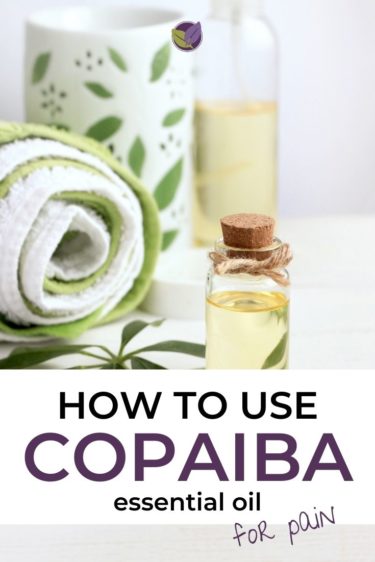 Copaiba essential oil is popular for natural pain relief, treating inflammation and wounds. In emotional aromatherapy, it addresses stress and anxiety.
Copaiba essential oil is popular for natural pain relief, treating inflammation and wounds. In emotional aromatherapy, it addresses stress and anxiety.
While Copaiba is not as popular as Lavender oil, it is a powerful addition to your essential oils library.
To help you start using this oil, I have collected my favorite copaiba essential oil recipes for pain. You’ll learn how to use Copaiba as part of DIY recipes for pain.
This post contains affiliate links, which means if you make a purchase through these links, I may receive a small commission at no extra cost to you. Read my full disclosure policy here.
Where does Copaiba Oil come from?
Copaiba essential oil is steam distilled from the sap or resin of a South American leguminous tree, the Copaiba tree. Its latin name is Copaifera reticulata, which belongs to the Caehhsalpinaceae family.
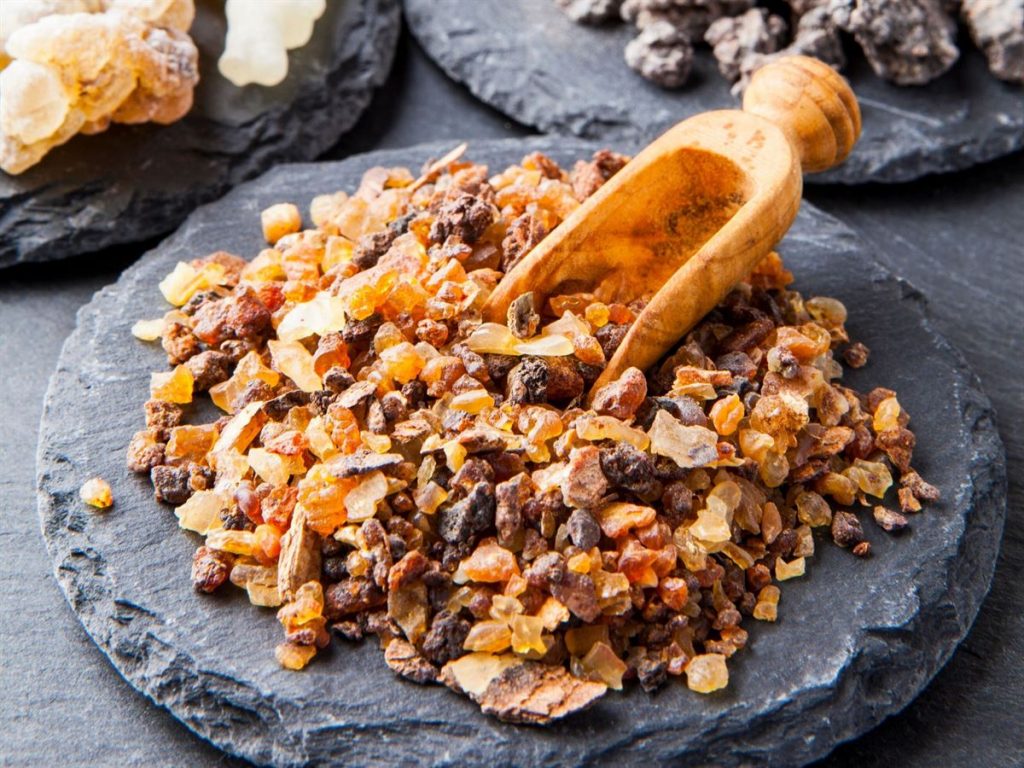
Copaiba Resin
Interestingly, each Copaiba tree can yield 11 US gallons of oil per year. That is 1,300 US gallons per hectare! ¹
The tapping to harvest Copaiba oleoresin is completely harmless to the tree. This is why production of Copaiba oil is still continuous and sustainable. Please use copaiba oleoresin in preference to the distilled oil, as it is more environmentally friendly – no trees or branches are cut down. ²
Copaiba is yellow to yellow amber in color, and is slightly viscous in nature.
Folk medicine used Copaiba essential oil either orally or as an ointment.
Recent studies have revealed that the advantages of Copaiba are due to its anti-inflammatory, antiseptic and anti-hemorrhagic properties. People in the Amazon use Copaiba balm for healing wounds, anti-inflammatory uses, and relieving pain.
Copaiba Benefits for Pain
Copaiba is one of the first oils I reach for when trying to treat general aches and pains in a natural way.
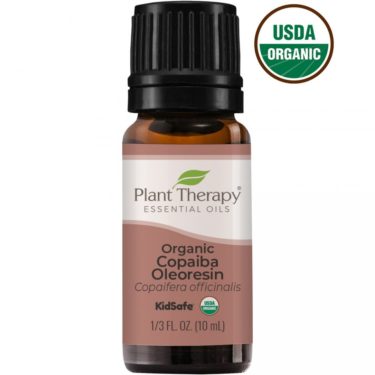
Copaiba essential oil
Get it Here
Why use Copaiba? How does it work anyway? Here are some of the benefits Copaiba oil may offer you for pain relief.
- Copaiba has beta-caryophyllene (β-caryophyllene) as its main component. This chemical component has analgesic or pain-killing properties. It additionally has cardiovascular and immune strengthening benefits.
- Inflammation is associated with a wide range of aches and pains, from arthritis to muscle spasms. Beta-caryophyllene is also a potent anti-inflammatory agent.
- Copaiba provides relief from physical pain without any psychoactive side effects like marijuana (which also has beta-caryophyllene).
- Beta-caryophyllene can minimize stress through controlling the individual’s reaction to irritation and triggers.
- Another compound found in Copaiba oil is humulene, which plays its role in healing wounds. Copaene, which is an antioxidant and microorganism-fighter, is also found in Copaiba essential oil.
How to Use Copaiba Essential Oil for Pain Relief
The best ways to use Copaiba include:
- Dilute oil with fractionated coconut oil for topical application. Use up to 3 times daily anywhere you feel physical pain. Remember that too much essential oils can also be detrimental to your health.
- Apply a 2% dilution of Copaiba oil on the soles of your feet for a relaxed and deep sleep. This would help stressed people the most.
Get the Complete Guide to Dilution Rates here, and learn about carrier oils here. Never apply essential oils directly on your skin, which is also referred to as applying them neat.
Copaiba Blends Well With
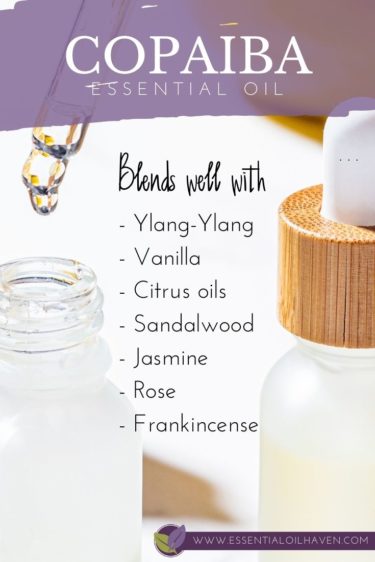
Blend it with:
- Ylang-Ylang
- Vanilla
- Citrus oils
- Sandalwood
- Jasmine
- Rose
- Frankincense
Using these oils together may create greater impacts on a person’s health. When essential oils are paired together, their chemical make-up reacts with each other. This can enhance the desired effects of your aromatherapy goals.
Copaiba Essential Oil Recipes for Pain
Here are a few recipes you can use Copaiba oil with and enjoy its pain soothing benefits.
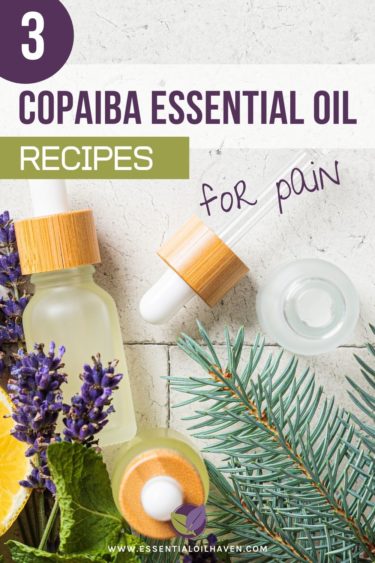
Copaiba Massage Oil
- 2 oz Sweet Almond carrier oil
- 18 drops Copaiba essential oil
- 9 drops Frankincense essential oil
- 9 drops Lavender essential oil
Blend all ingredients in an amber glass bottle (like these ones here). Store in a cool, dry place.
Copaiba Night Time Foot Rub
- 1 tsp Fractionated Coconut (FCO) carrier oil
- 3 drops Copaiba essential oil
Pour the small amount of FCO into the palm of your hand. Add the drops of Copaiba. Rub hands together, and apply immediately onto the soles of your feet. Use for stress relief and immunity boosting effects.
Copaiba Roller Bottle Blend
- 10 ml Fractionated Coconut Oil (FCO) carrier oil
- 8 drops Copaiba essential oil
- 3 drops Black Pepper essential oil
- 2 drops Ylang Ylang essential oil
- 2 drops Geranium essential oil
Get an amber glass roll-on bottle (like these cuties here), and start with your essential oils. Top up with FCO and shake to blend. Use for spot applications to treat pain, scars, or wounds.
Copaiba Buying Tips
When buying Copaiba, please ensure its quality and safety for your health by shopping with a reputable essential oil company. Spend some time to find out if the seller of the product is trustworthy. It makes all the difference! Sticking with a company you have done business with in the past is a recommendation, too.
When buying, you must also consider a few more things:
- The essential oil must have its Latin name on the label. This can be any of the varieties officinalis, langsdorfii or reticulata. If you want, check the individual chemical composition of each of these oils.
- Somewhere on the seller’s page there should be a mention of the country where the oil is from. This lets you confirm sustainability and ethical sourcing.
- Since essential oils dissolve plastic and often oxidize in direct light and heat, make sure it is packaged in a dark colored glass bottle.
Precautions
Nevertheless, it is always recommended to check with your medical professional to see what specific essential oils may be deemed suitable for you. This is especially important if you are pregnant or nursing a child. Further, taking another medication or having a medical condition can have an impact. please do your own due diligence before using Copaiba essential oil as a natural home remedy.
References
¹ Copaiba Wiki: https://en.wikipedia.org/wiki/Copaiba
² Copaiba Oil, Tisserand Institute: https://tisserandinstitute.org/learn-more/copaiba-oil/







Wonderful! I’m going to buy now! Thank you
I’m starting to take copaiba in a capsule. How many times a day are recommended ?
Hi. I found your article on Copaiba Essential Oil interesting and helpful. I recently had a knee replacement. Adding Copaiba Essential Oil to my pain reduction I’m looking forward to. I also found the other uses of Copaiba Essential Oil fun to know. Where Copaiba comes from was interesting.
Thank You. John